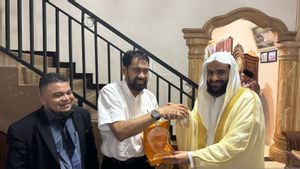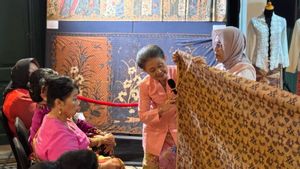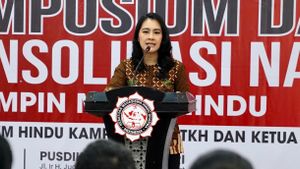JAKARTA - The attractiveness of the Nusantara Earth is endless to be admired. Starting from the beauty of nature (including flora and fauna), cultural diversity, traditional music, and the people in it.
Presumably, that is the reason that can invite admiration for people of various ethnic groups to come, taste, and enjoy the magical power offered by Bumi Nusantara (Indonesia).
Some of them were Thomas Stamford Raffles (Governor General of the Dutch East Indies 1811-1816) in introducing the public to the ins and outs of the riches of the land of Java with the power to visit and collect ancient archipelago manuscripts. Then there is Alfreed Ruseel Wallace (Naturalist) who introduces us to the richness of flora and fauna in the archipelago by entering and leaving the forest from Kalimantan to Papua.
And there is the name Jaap Kunst who researches related artistic activities (especially the art of music) which has become a tradition in Indonesia from Sumatra, Java, Bali, East Nusa Tenggara, Maluku, to Papua.
Especially for Jaap Kunst, the audience later became aware of the richness of music or the traditions of sounds that exist in the Nusantara archipelago, even though they are not as famous as the two names above. For that, let's get to know this one figure.
His full name is Jakob Kunst, he was born in Groningen (Netherlands) on August 12, 1891, and is the only child of a pianist musician couple. Therefore, it was only natural that art blood flowed in his blood.
In fact, since he was little he was interested in learning the violin. So, when he turned 21 years old, the Groningen Symponie Orkest became Kunst's work platform for six months.
Interestingly, at that time young Kunst was not only good at playing musical instruments, but also became interested in researching local musical arts, such as folk songs of the island of Terschelling, as well as taking his research results, as his first book in 1915.
Even so, he himself did not graduate from a music school. Especially in 1917, he graduated and earned a law degree from the University of Groningen. That automatically took him to work at a branch of the Amsterdam Bank in Utrecht for three months. Then continued for a year working in the Department of Education at the Mayor's office of Amsterdam.
Because the blood of the musicians was flowing profusely, the pleasure of being at the work table was not very much to her. He is more interested in music, sounds, and of course art.
The name of the Dutch East Indies only occurred to him when several life problems began to appear one by one. Starting from failed engagements, family ties, and disappointments with the workplace.
That was a series of reasons sometimes used by the Dutch to want to think of the Dutch East Indies as the next port to make a living. Why not, if you think about it normally, no one would want to pawn the comfort in the Netherlands, in order to be adrift on a ship for the Indies for a long time.
But not for Kunst and his two fellow musicians, namely Kitty Rolelants (singer), and Jan Wagenaar (pianist) who started their journey to the Indies in 1919. It seems that the trio of musicians enjoyed the Dutch East Indies quite well. This can be seen because in just eight months, they have appeared in a variety of shows in social clubs and arts circles, both in Java, Sumatra, Kalimantan and Sulawesi.
Kunst could have enjoyed his time in the Indies, because he was captivated by the melodious sound of the gamelan he heard for the first time at Christmas in 1919 at the Pakualaman Palace, Yogyakarta. But not with his two colleagues. Both of them returned to the Netherlands (in May 1921).
So that in the same year (1921), the blessing of settling in the Indies was the right step for Kunst to marry Kathy Van Wely (a French teacher). Kathy is someone who fully supports Kunst in Ethnomusicology research in Indonesia.
Furthermore, during the years 1930-1932, Kunst started his journey around Indonesia to research while documenting art activities ranging from Batak, Nias, Bengkulu, Kalimantan, Sulawesi, East Nusa Tenggara, Maluku, to Papua.
At the same time, in 1932, he moved to Batavia and got a job as a musical instrument curator at the Koninklijk Bataviaasch Genootschap van Kunsten en Wetenschappen (now the National Museum), where he kept thousands of collections of musical instruments collected during his travels, recordings, photographs , films to be used as research material.
The Intention of His Excellency Jaap Kunst
All the history about Kunst was obtained none other than because there was a discussion and exhibition entitled "Tracing the Traces of Jaap Kunst" at the National Museum, which took place from 28 November 2019 - 10 January 2020.
Through the event, the protesters understood that he had a very noble intention to tour the archipelago because he was worried that the extinction of the traditional art of Nusantara music would not be left for generations to come.
Jaap Kunst fell in love with traditional Nusantara music when he met Gamelan music, how about you? Let's learn gamelan! Every Sunday at the National Museum @Kemdikbud_RI @budayasaya pic.twitter.com/c4Ezgxn2xL
- National Museum of Ind. (@MuseumNasional) December 13, 2019
"So far, studying and studying Indonesian music and recording it for future generations is still possible. However, in a few years, in many places this opportunity may no longer exist. Even now, there are many areas where native / local music used to flourish. the complex is extinct, "Jaap Kunst once argued.
This is proof that the efforts made by him are too late. Because he has found facts related to many of the traditional music that has been lost.
Nusi Lisabila, Curator of the Exhibition, also spoke up. "In 1930, he (Kunst) felt he was late coming to Nias. Because he saw that many things were missing. Lost traditions, "said Nuri.
Nuri added that the current generation should be grateful to Jaap Kunst because Kunst collected personally, from personal money. "To the extent that, he said, he reduced his food rations so he could buy things and go anywhere," said Nuri.
In line with what Nuri said, Musicologist Palmer Ken, who was met when he was playing at the National Museum, expressed his opinion. "What is unique about Jaap Kunst is that he is the only ethmusicologist who dares to leave the house into the field, enter the village, enter the village, to look for music," said Palmer.
When compared to the present, the conditions are completely different. Because only by relying on the internet network, we can browse traditional music without having to move, as a starting point for the survey before finally going to the location.
In addition, armed with not a lot of time, recording tools tend to be unique, and impractical (heavy, fragile, very limited recording). For Kunst, it didn't really matter. He is still passionate about tracing the traditional musicians in the process of practicing until he directly participates in the ritual.
As a result, just before going to the Netherlands (for leave with the family on March 7, 1934), Kunst had moved the collection of musicology archives that he managed. About 1000 musical instruments, 325 wax cylinder records, 700 glass positives and 450 slides have been transferred to the National Museum.
Unfortunately, due to health reasons and the unavailability of research budget to the interior of the archipelago, Kunst's plan to return to the Indies could not be implemented. Therefore, he began to enjoy life again in his homeland as a curator in the Cultural anthropology department at the Coloniaal Instituut (Tropenmuseum) in Amsterdam, Netherlands in 1936.
In 1942, he became a special lecturer (without salary) in the Department of Comparative Musicology at the University of Amsterdam by teaching courses in Javanese history and music theory, as a guest lecturer in various parts of the world (such as France, South America & North America) speaking about music. Until finally Kunst died of cancer, at the age of 69 years.
Although Kunst never returned to Indonesia again, through his enthusiasm, research, and dozens of books (Music in Nias, Music in Java, etc.), it is thanks to people like Jaap Kunst that a unique variety of music can be found. enjoyed to this day.
The philosopher Nietzsche (Philosopher) once said: “Without music life would be a mistake.” From there we can again open our horizons to think that life is truly beautiful with a variety of music, including traditional music.
The English, Chinese, Japanese, Arabic, and French versions are automatically generated by the AI. So there may still be inaccuracies in translating, please always see Indonesian as our main language. (system supported by DigitalSiber.id)












